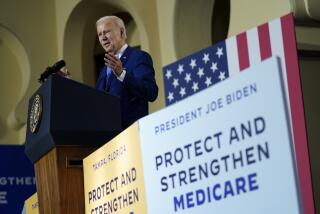Caring for the Medical Needs of the Elderly
- Share via
When millions answered America’s call to arms during World War II, Selective Service doctors were troubled to discover just how many of the nation’s fresh fighting men reported for duty in poor, untended health.
President Harry S. Truman was so disturbed by their widespread physical and mental incapacities that in 1945 he urged Congress to create a national health insurance system available to all Americans.
Truman’s vision, which revived a discarded tangent of the 1935 Social Security Act, has never been achieved. However, his failed effort ignited a national debate that ebbed and flowed for two decades and, in 1965, led to the creation of Medicare, the politically popular health care program that today covers 39 million older and disabled Americans.
That Medicare took 20 years to pass, stymied by the opposition of the American Medical Assn. and congressional conservatives, underscores why the federal entitlement program remains one of the nation’s most charged political issues almost 35 years later.
Even now, President Clinton and the Republican-led Congress are divided over how best to seal gaping holes in Medicare coverage, and rescue the program from possible insolvency in the century ahead.
Before Medicare, more than one-third of elderly Americans fell below the official poverty line and only about one-half had hospital insurance of any kind. Many of those who fell ill were forced to drain their life savings, rely on the charity of their children or community, or just suffer without care.
After Truman’s effort at national health insurance foundered, U.S. Rep. Aime Forand of Rhode Island fashioned a scaled-down compromise in 1957 that would provide hospital care for the nation’s elderly. Forand quickly won a powerful ally, then-U.S. Sen. John F. Kennedy, who after his election to the White House in 1960 vowed to make the program one of his chief legislative goals.
Kennedy was unable to get the measure through Congress. But then the 1964 election gave President Lyndon Johnson a landslide win and his Democratic Party a larger majority in Congress than any president had enjoyed since Franklin D. Roosevelt in the 1930s.
Within a year, Medicare flew through Congress in the crush of Johnson’s Great Society and War on Poverty initiatives. Johnson signed Medicare into law on the steps of the Truman Library in Independence, Mo., with Truman, 81, at his side.
“No longer will older Americans be denied the healing miracle of modern medicine,” Johnson said. “No longer will illness crush and destroy the savings that they have so carefully put away over a lifetime so that they might enjoy dignity in their later years. No longer will young families see their own incomes, and their own hopes, eaten away simply because they are carrying out their deep moral obligations to their parents.”
*
When enacted in 1966, the Medicare Act provided health care insurance for nearly 20 million elderly Americans, doubling the number of those with coverage. Medicare, then and now, pays for hospital and nursing home care, and includes a voluntary supplementary program that covers 80% of their doctors bills and laboratory tests for those beneficiaries who pay a small monthly premium.
Even many of the Great Society’s harshest critics, including sociologist Charles Murray, the author of “Losing Ground,” have conceded that providing aid to the elderly has saved many older Americans from a life of poverty.
Medicare and Social Security, while not given only to the poor, helped to slash the poverty rate for the elderly from 28.5% in 1965 to 12% by the beginning of the 1990s--by far the biggest success story of the War on Poverty. The average American life span has increased by six years since Medicare was adopted, and today Medicare doles out $200 billion a year and handles more than 1 billion claims.
Medicare’s creators saw the program as the first step toward national health care coverage for all Americans, but those dreams have never been realized.
Today, Medicare covers only about half the actual medical costs of many senior citizens, leaving them without coverage for drugs, dental care, eyeglasses and most long-term care and other critical services.
Medicare also is the fastest-growing of all federal programs, and consumes almost 2.5% of the total value of the nation’s output of goods and services, according to a study by the national Academy of Social Insurance. And when the 76 million baby boomers reach retirement age, Medicare will go from serving 1 in 10 Americans to caring for nearly 1 in 5.
More to Read
Sign up for Essential California
The most important California stories and recommendations in your inbox every morning.
You may occasionally receive promotional content from the Los Angeles Times.














